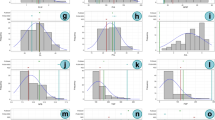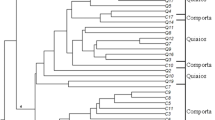Abstract
Wild relatives are important genetic resources for crop improvement. However, basic information about their population structure, genetic diversity, species relationships and distribution of variation in a gene pool remains scanty in Vigna species. The level of genetic diversity and population genetic structure of representative accessions of cultivated and wild Asiatic Vigna species collected from diversity-rich endemic areas of India have been investigated using both microsatellite markers and morphological descriptors. Forty-one wild and 12 cultivated accessions of 13 Vigna species were genotyped using 53 polymorphic microsatellite markers. A total of 539 alleles were detected among 53 accessions at all loci with an average 10.16 alleles per locus. The major allele frequency varied from 0.16 to 0.65 (mean = 0.30), while polymorphism information content of polymorphic markers ranged from 0.47 to 0.89 (mean = 0.79). The UPGMA revealed five major clusters accommodating ~96 % of the accessions. The largest cluster accommodated 19 (36 %), while the smallest cluster had only two accessions. Two accessions, JAP/10-5 and JAP/10-9 of V. trilobata, did not group with any other accession. The model-based population structure analysis also showed almost similar pattern and grouped 53 accessions of Vigna into five genetically distinct sub-populations (K = 5) based on maximum ∆K values. Duncan’s multiple range test revealed significant difference between five genetic and one admixture group developed through population structure analysis with 22 morphological descriptors. Analysis of variance for morphological data revealed significant difference in 12 qualitative and quantitative traits including growth habit, terminal leaflet length, colour of petiole base, petiole length, leaf senescence, length of peduncle, raceme position, calyx colour, colour of VSI pod, pod pubescence, pod curvature and 100-seed weight, indicating their significance in distinguishing population groups. The information on genetic diversity and population structure of wild and cultivated accessions of Asiatic Vigna will be tremendously useful to accelerate their use in trait improvement.


Similar content being viewed by others
References
Armuganathan K, Earle ED (1991) Nuclear DNA content of some important plant species. Plant Mol Biol Rep 9:208–218
Baudoin JP, Marechal R (1988) Taxonomy and evolution of the genus Vigna. In: Shanmugasundaram S, McLean BT (eds) Mungbean: Proceedings of the Second International Symposium. Taiwan: Asian Vegetable Research and Development Center, pp 2–12
Bisht IS, Bhat KV, Lakhanpaul S, Latha M, Jayan PK, Biswas BK, Singh AK (2005) Diversity and genetic resources of wild Vigna species in India. Genet Res Crop Evol 52:53–68
Blair MW, Pedraza F, Buendia HF, Gaitán-Solís E, Beebe SE, Gepts P, Tohme J (2003) Development of a genome-wide anchored microsatellite map for common bean (Phaseolus vulgaris L.). Theor Appl Genet 107:1362–1374
Botstein D, White RL, Skolnick M, Davis RW (1980) Construction of genetic linkage map in man using restriction fragment length polymorphisms. Am J Hum Genet 32:314–331
Chandel KPS (1984) Role of wild Vigna species in the evolution and improvement of mungbean [Vigna radiata (L.) Wilczek] and urdbean [V. mungo (L.)] Hepper]. Ann Agric Res 5:98–111
Chankaew S, Isemura T, Isobe S, Kaga A, Tomooka N, Somta P, Hirakawa H, Shirasawa K, Vaughan DA, Srinives P (2014) Detection of genome donor species of neglected tetraploid crop Vigna reflexo-pilosa (creole bean), and genetic structure of diploid species based on newly developed EST-SSR markers from Azuki bean (Vigna angularis). PLoS One 9(8):e104990
Chapuis MP, Estoup A (2007) Microsatellite null alleles and estimation of population differentiation. Mol Biol Evol 24:621–631
Dana S (1964) Interspecific cross between tetraploid Phaseolus species and P. ricciardianus Ten. Nucleus 7:1–10
de Candolle A (1886) Origin of cultivated plants. Hafner, New York
Doyle JJ, Doyle JL (1990) Isolation of plant DNA from fresh tissue. Focus 12:13–15
Earl DA, VonHoldt BM (2012) STRUCTURE HARVESTER: a website and program for visualizing STRUCTURE output and implementing the Evanno method. Conserv Genet Resour 4:359–361
Egawa Y, Tomooka N (1991) In: JIRCAS International symposium series 2 (Tsukuba, Japan), pp 112–120
Evanno G, Regnaut S, Goudet J (2005) Detecting the number of clusters of individuals using the software STRUCTURE: a simulation study. Mol Ecol 14:2611–2620
Gaitan-Solis E, Duque MC, Edwards KJ, Tohme J (2002) Microsatellite repeats in common bean (Phaseolus vulgaris): isolation, characterization and cross-species amplification in Phaseolus ssp. Crop Sci 42:2128–2136
Gupta S, Gupta DS, Anjum KT, Pratap A, Kumar J (2013) Transferability of simple sequence repeat markers in blackgram. Aust J Crop Sci 7:345–353
Gwag JG, Dixit A, Park YJ, Ma KH, Kwon SJ, Cho GT, Lee GA, Lee SY, Kang HK, Lee SH (2010) Assessment of genetic diversity and population structure in mungbean. Genes Genomics 32:299–308
Han OK, Kaga A, Isemura T, Wang XW, Tomooka N, Vaughan DA (2005) A genetic linkage map for azuki bean [Vigna angularis (Willd.) Ohwi & Ohashi]. Theor Appl Genet 111:1288–1299
Konarev A, Vaughan D, Shewry P (2000) Insect and fungal enzyme inhibitors in study of plant variability and evolution. Czech J Genet Plant Breed 36:121–123
Kumar SV, Tan SG, Quah SC, Yusoff K (2002a) Isolation of microsatellite markers in mungbean, Vigna radiata. Mol Ecol Notes 2:96–98
Kumar SV, Tan SG, Quah SC, Yusoff K (2002b) Isolation and characterization of seven tetranucleotide microsatellite loci in mungbean, Vigna radiata. Mol Ecol Notes 2:293–295
Lawn RJ (1995) The Asiatic Vigna species. In: Smartt J, Simmonds NW (eds) The evolution of crop plants. Longman, Harlow, U.K, pp 321–326
Lawn RJ, Cottrell A (1988) Wild mungbean and its relatives in Australia. Biologist (Columbus, Ohio) 35:267–273
Li CD, Fatokun CA, Ubi B, Singh BB, Scoles GJ (2001) Determining genetic similarities and relationships among cowpea breeding lines and cultivars by microsatellite markers. Crop Sci 41:189–197
Liu K, Muse SV (2005) Power marker: integrated analysis environment for genetic marker data. Bioinformatics 21:2128–2129
Marechal R, Mascherpa JM, Stainier F (1978) Etude taxonomique d’un groupe d’especes des genres Phaseolus et Vigna (Papilonaceae) sur la base des donnees morphologiques et polliques, traitees pour l’analyse informatique. Boissiera 28:1–273
Mohan M, Nair S, Bhagwat A, Krishna TG, Yano M, Bhatia CR, Sasaki T (1997) Genome mapping, molecular markers and markers-assisted selection in crop plants. Mol Breed 3:87–103
Mondini L, Noorani A, Pagnotta MA (2009) Assessing plant genetic diversity by molecular tools. Diversity 1:19–35
Pandiyan M, Ramamoorthi N, Ganesh SK, Jebaraj S, Nagarajan P, Balasubramanian P (2008) Broadening the genetic base and introgression of MYMV resistance and yield improvement through unexplored genes from wild relatives in mungbean. Plant Mutat Rep 2:33–43
Parida A, Raina S, Narayan R (1990) Quantitative DNA variation between and within chromosome complements of Vigna species (Fabaceae). Genetica 82:125–133
Parker PG, Snow AA, Schug MD, Booton GC, Fuerst PA (1998) What molecules can tell us about populations: choosing and using a molecular marker. Ecology 79:361–382
Pratap A, Gupta DS, Singh BB, Kumar S (2013) Development of super early genotypes in Mungbean [(Vigna radiata (L.) Wilczek]. Legumes Res 36:105–110
Pratap A, Basu PS, Gupta S, Malviya N, Rajan N, Tomar R, Madhavan L, Nadarajan N, Singh NP (2014a) Identification and characterization of sources for photo- and thermo-insensitivity in Vigna species. Plant Breed 133:756–764
Pratap A, Malviya N, Tomar R, Gupta DS, Kumar J (2014b) Vigna. In: Pratap A, Kumar J (eds) Alien gene transfer in crop plants, vol 2. Springer, New York, pp 163–189
Pritchard JK, Stephens M, Donnelly P (2000) Inference of population structure using multilocus genotype data. Genetics 155:945–959
Ribeiro-Carvalho C, Guedes-pinto H, Igrejas G, Stephenson P, Schwarzacher T, Heslop-Harrison JS (2004) High levels of genetic diversity throughout the range of the portuguese wheat landrace ‘barbela’. Ann Bot 94:699–705
Rohlf FJ (2000) NTSYS-pc numerical taxonomy and multivariate analysis system, version 2.1. Exeter Publ, New York
Sangiri C, Kaga A, Tomooka N (2007) Genetic diversity of the mungbean (Vigna radiata) gene pool on the basis of microsatellite analysis. Aust J Bot 55:837–847
Singh DP (1994) Breeding for resistant to disease in mungbean: problems and prospects. In: Asthana AN, Kim DH (eds) Recent advances in Mungbean Research. Indian Society of Pulseas Research (IIPR) Kanpur, India, pp 152–164
Singh M, Bisht IS, Sardana S, Gautam NK, Hussain Z, Gupta S, Singh BB, Dwivedi NK (2006) Asiatic Vigna. In: Dhillon BS, Saxena S, Agrawal A, Tyagi RK (eds) Plant genetic resources: food grain crops. Narosa Publishing House Pvt. Ltd., New Delhi, India, pp 275-301
Smartt J (1985) Evolution of grain legumes. III. Pulses in the genus Vigna. Exp Agric 21:87–100
Somta P, Kaga A, Tomooka N, Kashiwaba K, Isemura T, Chaitieng B, Srinives P, Vaughan DA (2006) Development of an interspecific Vigna linkage map between Vigna umbellata (Thunb.) Ohwi & Ohashi and V. nakashimae (Ohwi) Ohwi & Ohashi and its use in analysis of bruchid resistance and comparative genomics. Plant Breed 125:77–84
Somta P, Seehalak W, Srinives P (2009a) Development, characterization and cross-species amplification of mungbean (Vigna radiata) genic microsatellite markers. Conserv Genet 10:1939–1943
Somta P, Sommanas W, Srinives P (2009b) Molecular diversity assessment of AVRDC—the World Vegetable Center eliteparental mungbeans. Breed Sci 59:149–157
Tateishi Y (1985) A revision of the Azuki bean group, the subgenus Ceratotropis of the genus Vigna (Leguminosae). Ph.D. Thesis, Tohoku University, Sendai, Japan
Tomooka N, Lairungreang Nakeeraks P, Egawa Y, Thavarasook C (1992) Development of Burchid-resistant mungbean line using wild mungbean germplasm in Thailand. Plant Breed 109:60–66
Tomooka N, Kaga A, Egawa Y, Vaughan DA, Kashiwab K, Doi K (2001) Searching for sources of vegetative stage high temperate tolerance in the genus Vigna subgenus Ceratotropis. Jpn J Trop Agric 45:47–48
Tomooka N, Kaga A, Vaughan DA, Jayasuriya AHM (2003) Advances in understanding the genus Vigna subgenus Ceratotropis. In: Jayasuriya AHM, Vaughan DA (eds) Conservation and use of crop wild relatives. Proc Joint Dept Agric, Sri Lanka and Nat Inst Agrobiol Sci, Japan Workshop. Plant Genetic Resources Centre, Dept Agric, Sri Lanka, pp 25–35
Tomooka N, Kaga A, Vaughan DA (2006) The Asian Vigna (Vigna subgenus Ceratotropsis) biodiversity and evolution. In: Sharma AK, Sharma A (eds) Plant genome: biodiversity and evolution. Part C phanerogames (angiosperms-dicoltyledons), vol 1. Science Publishers, Enfield, pp 87–126
Vavilov NI (1926) Studies on the origin of cultivated plants (Russian). Bull Appl Bot Plant Breed 14:1–245
Wang XW, Kaga A, Toomoka N, Vaughan DA (2004) The development of SSR markers by a new method in plants and their application to gene flow studies in azuki bean [Vigna angularis (Willd.) Ohwi & Ohashi]. Theor Appl Genet 109:352–360
Wang XQ, Kwon SW, Park YJ (2012) Comparison of population genetic structures between Asian and American mungbean accessions using SSR Markers. Agric Sci 4:150–158
Zhao WG, Chung JW, ChoYI Rha WH, Lee GA, Ma KH, Park YJ (2010) Molecular genetic diversity and population structure in Lycium accessions using SSR markers. C R Biol 333:793–800
Acknowledgments
We are thankful to National Innovations in Climate Resilient Agriculture (NICRA), ICAR, Govt. of India, for providing financial support to carry out this research. The corresponding author is also thankful to Head, Crop Improvement Division, for providing necessary facilities for carrying out this research.
Author information
Authors and Affiliations
Corresponding author
Electronic supplementary material
Below is the link to the electronic supplementary material.
Rights and permissions
About this article
Cite this article
Pratap, A., Gupta, S., Malviya, N. et al. Genome scanning of Asiatic Vigna species for discerning population genetic structure based on microsatellite variation. Mol Breeding 35, 178 (2015). https://doi.org/10.1007/s11032-015-0355-9
Received:
Accepted:
Published:
DOI: https://doi.org/10.1007/s11032-015-0355-9




